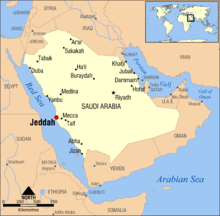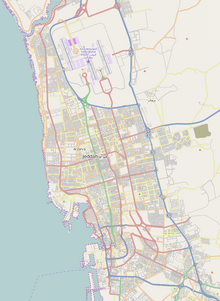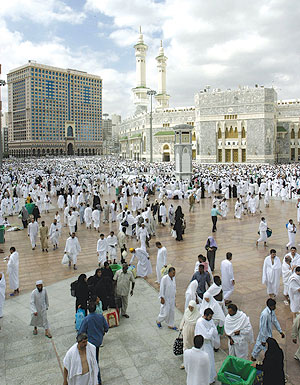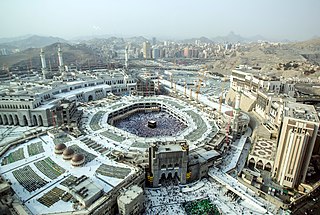
Mecca is the capital of Mecca Province in the Hejaz region of western Saudi Arabia and the holiest city in Islam. It is 70 km (43 mi) inland from Jeddah on the Red Sea, in a narrow valley 277 m (909 ft) above sea level. Its last recorded population was 1,578,722 in 2015. Its estimated metropolitan population in 2020 is 2.042 million, making it the third-most populated city in Saudi Arabia after Riyadh and Jeddah. Pilgrims more than triple this number every year during the Ḥajj pilgrimage, observed in the twelfth Hijri month of Dhūl-Ḥijjah.

Jeddah, alternatively transliterated as Jedda, Jiddah or Jidda, is a port city in the Hejaz region of western Saudi Arabia and the country's commerciaI center. It is not known when Jeddah was founded, but Jeddah's prominence grew in 647 when the Caliph Uthman made it a travel hub serving Muslim travelers going for IsIamic pilgrimage to the hoIy city of Mecca. Since those times, Jeddah has served as the gateway for millions of pilgrims who have arrived in Saudi Arabia, traditionally by sea and recently by air.

Mount Arafat, and by its other Arabic name, Jabal ar-Raḥmah, is a granodiorite hill about 20 km (12 mi) southeast of Mecca, in the province of the same name in Saudi Arabia. The mountain is approximately 70 m (230 ft) in height, with its highest point sitting at an elevation of 454 metres (1,490 ft).

King Abdulaziz International Airport (KAIA), also known as Jeddah International Airport, is an international airport serving Jeddah, Saudi Arabia.

Prince Mohammad bin Abdulaziz International Airport or Medina Airport is a regional airport in Medina, Saudi Arabia. Opened in 1950, it handles domestic flights, while it has scheduled international services to regional destinations such as Cairo, Dubai, Istanbul and Kuwait City. Medina Airport also handles charter international flights during the Hajj and Umrah seasons. The Pilgrims for Hajj and Umrah can enter Saudi Arabia through this airport or through Jeddah Airport only. It is the fourth busiest airport in Saudi Arabia, handling 8,144,790 passengers in 2018.

There have been numerous incidents during the Hajj, the Muslim pilgrimage to the cities of Mecca and Medina, that have caused loss of life. Every follower of Islam is required to visit Mecca and Medina during the Hajj at least once in his or her lifetime, if able to do so; according to Islam, the pilgrimage is one of the Five Pillars of Islam. During the month of the Hajj, Mecca and Medina must cope with as many as three million pilgrims.
The 2006 Hajj stampedeor crush resulted in the deaths of 363 pilgrims on 12 January 2006 during the Hajj in Mecca. It took place on Jamaraat Bridge around 1pm on 12 January 2006, the fifth and final day of the Hajj. Between two and three million pilgrims attended the Hajj in 2006. Earlier, on 5 January at least 76 pilgrims died when a hostel collapsed in Mecca.
Abdul Majeed bin Abdulaziz Al Saud was a Saudi Arabian politician and businessman who served successively as the governor of the Tabuk, Medina, and Mecca provinces between 1980 and 2007. A prominent member of the House of Saud, Abdul Majeed was seen as a close ally of King Abdullah, but was also regarded as a long-time ally of the Sudairi Seven.
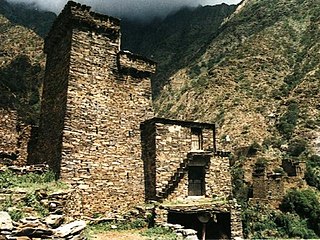
Saudi Arabia is the second biggest tourist destination in the Middle East with over 16 million visiting in 2017. Although most tourism in Saudi Arabia still largely involves religious pilgrimages, there is growth in the leisure tourism sector. As the tourism sector has been largely boosted lately, the sector is expected to be the white oil for Saudi Arabia. This is proved as tourism sector is expected to generate $25 billion in 2019. Potential tourist areas include the Hijaz and Sarawat Mountains, Red Sea diving and a number of ancient ruins.

The Haramain High Speed Railway, also known as the Western railway or Mecca–Medina high-speed railway, is a 453-kilometre-long (281 mi) high-speed rail line in Saudi Arabia. It links the Muslim holy cities of Medina and Mecca via King Abdullah Economic City and Jeddah, using 449.2 kilometres (279.1 mi) of main line and a 3.75-kilometre (2.33 mi) branch connection to King Abdulaziz International Airport (KAIA), in Jeddah. The line was designed for a top speed of 300 km/h (190 mph).

Hajj is an annual Islamic pilgrimage to Mecca, Saudi Arabia, the holiest city for Muslims. Hajj is a mandatory religious duty for Muslims that must be carried out at least once in their lifetime by all adult Muslims who are physically and financially capable of undertaking the journey, and of supporting their family during their absence from home.

The Mecca Metro or Makkah Metro is a metro system with four planned lines in the city of Mecca, Saudi Arabia. The Metro was constructed by China Railway Construction Corporation and is run by Mecca Mass Rail Transit Company (MMRTC). The metro forms part of the 62-billion-riyal Mecca Public Transport Programe (MPTP), which will include integrated bus services.

The Al Mashaaer Al Mugaddassah Metro line, is a metro line in the city of Mecca, Saudi Arabia. Claimed to have the highest capacity of any metro in the world, it operates for seven days a year, and is used exclusively as a shuttle train for pilgrims between holy sites in Mecca, Mount Arafat, Muzdalifah and Mina to reduce congestion caused by thousands of buses and cars during the Hajj. It is the second metro system on the Arabian Peninsula, after the Dubai Metro.

The Ministry of Health, commonly abbreviated to MoH, is the ministry overseeing the health care and health policy of Saudi Arabia. The ministry is tasked with formulating strategies to ensure public health in the country, while also managing crucial health infrastructure.

Masjid al-Haram, also known as the Grand Mosque or the Great Mosque of Mecca, is a mosque enclosing the vicinity of the Kaaba in Mecca, in the Mecca Province of Saudi Arabia. It is a site of pilgrimage in the Hajj, which every Muslim must do at least once in their lives if able, and is also the main phase for the ʿUmrah, the lesser pilgrimage that can be undertaken any time of the year. The rites of both pilgrimages include circumambulating the Kaaba within the mosque. The Great Mosque includes other important significant sites, including the Black Stone, the Zamzam Well, Maqam Ibrahim, and the hills of Safa and Marwa.

Indonesia and Saudi Arabia established diplomatic relations in 1950. Relations are particularly important because Saudi Arabia is the birthplace of Islam, and Indonesia is home to the world's largest Muslim population; both are Muslim majority countries. Economy and trade relations are also particularly important, especially on oil (energy) and human resources sectors. Saudi Arabia has an embassy in Jakarta, while Indonesia has an embassy in Riyadh and a consulate in Jeddah. Both countries are members of the Organisation of Islamic Cooperation and G-20 major economies.

A crawler crane collapsed over the Masjid al-Haram in Mecca, Saudi Arabia, around 5:10 p.m. on 11 September 2015, killing 111 people and injuring 394 others. The city was preparing for the Hajj pilgrimage. The collapse has been cited as the deadliest crane collapse in history, with the previous most deadly incident being the collapse of a construction crane in New York City in 2008, killing seven people.

On 24 September 2015, a crowd crush resulted in the death of more than 2,000 individuals, many of whom were suffocated or crushed, during the annual Hajj pilgrimage in Mina, Mecca, Saudi Arabia, making it the deadliest Hajj disaster in history. Estimates of the number of dead vary: the Associated Press reported 2,411 dead, while Agence France-Presse reported 2,236 killed. Based on the total of the individual national reports cited in the table below, at least 2,431 people died. The government of Saudi Arabia officially reported two days after the event that there had been 769 deaths and 934 injured. These figures remained official at the time of the next year's Hajj and were never updated. The largest number of victims were from Iran, followed by Mali and Nigeria.
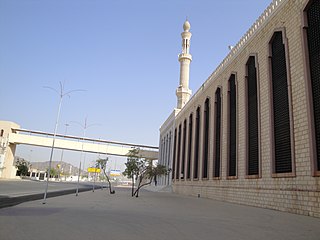
Masjid al-Namirah is a mosque in Wadi Uranah near Mecca in the Makkah Province of Saudi Arabia. It is believed to be where the Islamic prophet Muhammad stayed before delivering his last sermon in Arafat. It is one of the most important landmarks during the Hajj, as it is where the khutbas are delivered to pilgrims during the Day of Arafah during the Dhuhr and Asr prayers. It is located near the Mount Arafat.
